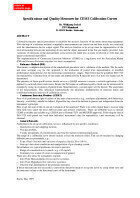Air Monitoring
Specifications and Quality Measures for CEMS Calibration Curves
Oct 06 2014
Author: Dr. Wolfgang Jockel on behalf of CEM
ABSTRACT
Calibration requires special procedures to establish the analysis function of the entire measuring equipment. With the help of a reference method, comparative measurements are carried out and their results are correlated with the simultaneous device output signal. The analysis function to be set up must be representative of the total relationship between the measuring device and the object measured in the flue gas matrix provided. Also variations of emissions in the measurement cross-section are taken into account in relation to both time and space (concentration profiles).
The implementation of Continuous Emission Monitors (CEMS) as a regulatory tool for Particulate Matter(PM) and Gaseous Pollutants requires two basic assumptions:
- Reference Method (RM)That means a complete description of the standardized procedure and a validation of the method. The favourite and most accepted way for this approach is the realisation of paired train measurements to establish performance characteristics for the interesting concentration ranges. Then following the guideline ISO 5725 the repeatability r (internal tests of one team) and reproducibility R (parallel tests of at least two teams) can be determined.
The presence of those specifications should serve as a QA/QS measure to ensure a suitable application of the method by each individual stack tester. Beside the ISO terms an additional quality check can be introduced for example by using an evaluation of paired trains. Simultaneously a second aspect will be known: The uncertainty of the measurement. This influences fundamentally the regulatory interpretation of emission limits and
confidence/tolerance intervals of calibration curves.
- Continuous Emission Monitors (CEMS)
First of all performance specifications of the main characteristics (e.g. zero/span adjustments, drift behaviour, linearity, availability) should be defined. If possible they should be defined in general and independent from the instrument’s principle.
How to get the state of the art and an evaluation of the monitors? There is no other chance than to execute long term field tests under the most difficult plant and process conditions. There are different ways to declare CEMS as reliable and suitable (e.g. USEPA test or German TUV and MCERTS approval). Following the idea of ISO 5725 with paired test work then individual instrument’s data for repeatability r and uncertainty will be
obtained.
- General Remarks
Furthermore the set up of calibration curves is influenced by site specific conditions:
- Installation site and sampling location,
- Flue gas profiles,
- Variaty (properties) of concentrations and base for statistics (limited population).
The range of a calibration curve should include at least the emission limits. This can be reached by changing different process parameters, e.g.:
- Type of fuel / fuel mix and variation of capacity (ideally 20 to 100 %),
- Start-up / shut-down conditions and manipulation of gas cleaning system.
Nevertheless two typical problems can exist in practice:
- Range of concentration is to small ( e.g. <10 mg/m³),
- Extremely low scatter of values (accumulation of points).
There are a few ideas for a pragmatic reaction:
- Zero Point Measurements (for extractive systems),
- Zero Point Hypothesis (for extractive systems),
- Dilution resp. enrichment of the pollutant measured
If those measures are not successful a convention should be made to set up the curve by using either zero and the measured values or the functional curve of the instrument.
Digital Edition
IET 34.2 March 2024
April 2024
Gas Detection - Biogas batch fermentation system for laboratory use with automatic gas analysis in real time Water/Wastewater - Upcycling sensors for sustainable nature management - Prist...
View all digital editions
Events
Apr 30 2024 Melbourne, Australia
Apr 30 2024 Birmingham, UK
May 03 2024 Seoul, South Korea
May 05 2024 Seville, Spain
May 06 2024 Minneapolis, MN, USA















